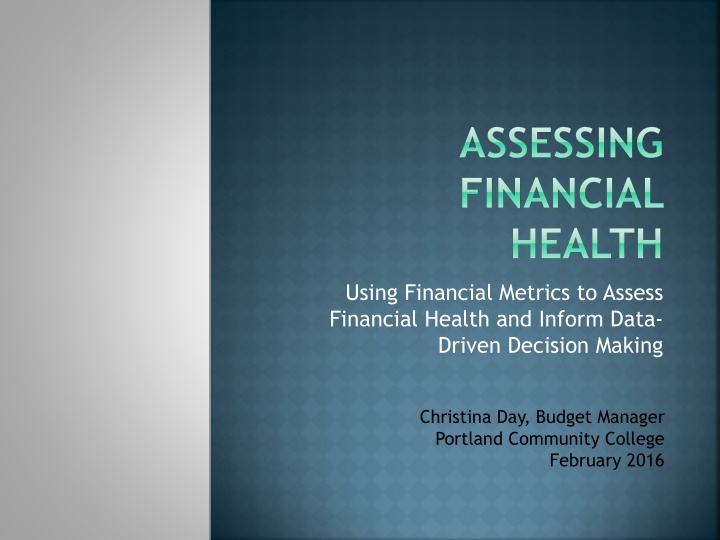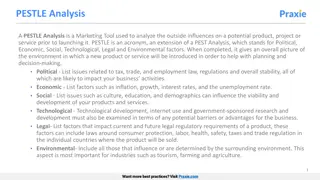Strategic Financial Analysis for Informed Decision Making
Utilizing financial metrics and ratios for assessing financial health and informing data-driven decision-making is crucial for institutions to align strategic goals, manage resources efficiently, and ensure competitiveness. Strategic financial analysis focuses on liquidity, debt management, asset performance, and operating results to gauge institutional financial health and support strategic direction.
Download Presentation

Please find below an Image/Link to download the presentation.
The content on the website is provided AS IS for your information and personal use only. It may not be sold, licensed, or shared on other websites without obtaining consent from the author.If you encounter any issues during the download, it is possible that the publisher has removed the file from their server.
You are allowed to download the files provided on this website for personal or commercial use, subject to the condition that they are used lawfully. All files are the property of their respective owners.
The content on the website is provided AS IS for your information and personal use only. It may not be sold, licensed, or shared on other websites without obtaining consent from the author.
E N D
Presentation Transcript
ASSESSING FINANCIAL HEALTH Using Financial Metrics to Assess Financial Health and Inform Data- Driven Decision Making Christina Day, Budget Manager Portland Community College February 2016
GOALS FOR TODAY Share tools for strategic financial analysis Discuss use of financial ratios for analysis Identify possible strategies for improved financial management
KEY FINANCIAL FOCUS FOR BOARD AND SENIOR LEADERSHIP If we are to pursue a growth strategy, how much resource do we have available today as a baseline to fund an expansion? Are we appropriately funding the activities that we have currently undertaken? How do we compare financially with our peer institutions - are we in a position to compete effectively? Where do we need to invest to meet our strategic goals, and do we have the funds available?
PURPOSE OF STRATEGIC FINANCIAL ANALYSIS The alignment of strategic financial goals with actions and risk assessment will improve strategic decision making and chances of institutional success. The mission, as articulated in the strategic plan, is the institutional driver; financial capacity and affordability measure the feasibility of the institution s aspirations. Prager, Sealy & Co. (2010) In other words Are we financially healthy enough to take actions and risks to meet our mission?
WHY USE STRATEGIC FINANCIAL RATIO ANALYSIS? Gauge the financial health of your institution to meet its mission Another lens for analysis quantifiable measures Benchmark with other institutions Identify areas for investment to improve performance and align to strategic goals Informs data-driven decisions Uses GAAP-adjusted CAFR data
STRATEGIC FINANCIAL ANALYSIS Liquidity - Are resources sufficient and flexible enough to support the mission? Debt Management - Are debt resources managed strategically to advance the mission? Asset Performance - Does asset performance and management support the strategic direction? Operating Results - Do operating results indicate the institution is living within available resources?
MEASURING LIQUIDITY Primary Reserve Ratio Are resources sufficient and flexible enough to support the mission? Formula: Expendable Net Assets Total Expenses This ratio measures the period that expenses could be covered without generating additional resources. Benchmark = .40 (40% of 12 mos ~ 5mos.)
ASSESSING DEBT MANAGEMENT Viability (Equity) Ratio Debt Burden Ratio Debt Service Coverage Ratio Are debt resources being managed strategically to advance the mission?
ASSESSING DEBT MANAGEMENT Viability (Equity) Ratio Are debt resources being managed strategically to advance the mission? Formula: Expendable Net Assets Long Term Debt (exc. Pension) This ratio assesses ability to respond to adverse conditions and fund initiatives with internal resources. Benchmark = 1.0 (1:1 Ratio)
ASSESSING DEBT MANAGEMENT Debt Burden Ratio Are debt resources being managed strategically to advance the mission? Formula: Debt Service Total Expenditures This ratio indicates the demand on resources to repay debt. Higher ratios may indicate higher prioritization of needed capital improvements. Benchmark = 7%
ASSESSING DEBT MANAGEMENT Debt Coverage Ratio Are debt resources being managed strategically to advance the mission? Formula: Adj Change in Net Assets Debt Service This ratio reflects the net revenue stream available to meet debt burden in changing economic conditions. The higher ratio the better! Benchmark = 1.2x
EVALUATING ASSET PERFORMANCE Return on Net Assets Ratio Physical Asset Reinvestment Ratio Facilities Burden Ratio Does Asset Performance and Management Support the Strategic Direction?
EVALUATING ASSET PERFORMANCE Return on Net Assets Does Asset Performance and Management Support the Strategic Direction? Formula: Change in Net Assets Total Net Assets This ratio reflects total economic returns on all equity, including operating & non-op revenues & expenses. Benchmark = 3-4%
EVALUATING ASSET PERFORMANCE Physical Asset Reinvestment Ratio Does Asset Performance and Management Support the Strategic Direction? Formula: Capital Expenditures Depreciation Expense This ratio calculates the extent to which capital renewal is occurring compared to physical asset usage. Benchmark = 1 (1:1 ratio)
EVALUATING ASSET PERFORMANCE Facilities Burden Ratio Does Asset Performance and Management Support the Strategic Direction? Formula: Facility Operation Expenses Net Capital Assets This ratio calculates the comprehensive impact(inc op and maint) of facilities investments on the budget. Benchmark = none
MEASURING OPERATING RESULTS Net Operating Revenue Is the institution living within available resources? Formula: Excess (Deficit) of Unrestricted Op Revenues Over Unrestricted Op Exp Total Unrestricted Operating Income This ratio explains how the surplus from operations (if any) affects the other core ratios. Benchmark = 2-4%
SAMPLE INSTITUTION RATIOS Primary Metrics for Strategic Financial Analysis 2011 2012 2013 2014 2015 5-yr Avg Benchmark Liquidity: Primary Reserve Ratio 0.32 0.16 0.63 0.35 0.11 0.31 .40 Debt Management: Viability Ratio Debt Burden Ratio Debt Service Covg Ratio 14.13% 5.71 1.29 13.23% 6.53 1.40 13.27% 5.71 1.20 17.76% 4.87 1.25 17.95% 4.92 0.88 1.20 1.25x - 2.0x 15% 5.55 <7% >1.2x Asset Performance and Management: Return on Net Assets Physical Asset Reinvestment Facilities Burden Ratio 10% 3.54 26% 5% 2.39 24% -0.2% 8.51 21% 21.0% 10.81 22% 13% 4.63 25% 10% 5.98 23% 3-4% 1 unk. Operating Results: Net Operating Rev/Income -11.77% -5.28% -18.90% -1.95% 3.37% -0.07 2-4%
COMPOSITE FINANCIAL INDEX Combines the 4 core ratios into a single score Primary reserve ratio Viability ratio Return on net assets ratio Net operating revenues ratio Attempts to quantify the overall financial well being of the institution
COMPOSITE FINANCIAL INDEX 4 steps: Compute value of 4 core ratios Convert to strength factors along a common scale for comparability (-4 to 10) Multiply strength factors by weight factors Total the 4 resulting numbers for single CFI score Score is an estimate only Most useful if historically trended Threshold value of financial health = 3
SAMPLE INSTITUTION CFI 5 year average = 2.28
NOW WHAT? Strategic Analysis and Decision-making focus in on priorities Compare to Strategic Plan and Goals Priority of student success how is that reflected in the ratios? Physical Asset Reinvestment ratio shows excellent facilities but too much? Need to adjust reinvestment? Primary Metrics for Strategic Financial Analysis 2011 2012 2013 2014 10.81 2015 5-yr Avg Benchmark 1 Physical Asset Reinvestment 3.54 2.39 8.51 4.63 5.98 Priority of financial sustainability is that reflected in the Primary Reserve ratio? Primary Metrics for Strategic Financial Analysis 2011 2012 2013 2014 2015 5-yr Avg Benchmark .40 Primary Reserve Ratio 0.32 0.16 0.63 0.35 0.11 0.31 Review trends Primary Metrics for Strategic Financial Analysis 2011 -11.77% 2012 -5.28% 2013 -18.90% 2014 -1.95% 2015 3.37% 5-yr Avg Benchmark 2-4% Net Operating Rev/Income -0.07
NOW WHAT? Look at components of each ratio to determine areas of potential change/focus Primary Reserve Ratio Expendable Net Assets: Unrestricted Net Assets Adj for GASB 68 prior period Net invested in plant Plant-related debt OPEB Liability Formula: Expendable Net Assets Total Expenses Adj for GASB 68 Total Expenses: Operating Expenses Non-Operating Expenses Total: Strategize actions that would impact the ratios
STRATEGIES What would change an institution s liquidity and improve the Primary Reserve ratio? Increase cash generated from operations Reduce unfunded liabilities (pension, retiree health) How can we make assets perform better? Improve utilization of existing buildings Optimize mix of owned/leased facilities Maintain adequate investment in deferred maintenance (increase or decrease current investment?) How can we impact operating results? Target adverse revenue and expense trends for improvement (i.e. margin enrollment) Improve operational productivity Develop and grow new revenue sources
MY GOALS FOR THIS TOOL AT PCC: Better manage financial health with a larger variety of tools Make data-driven decisions (i.e. Facilities) Align resource allocation with strategic goals Support responses to Board, senior leaders and stakeholders Quantify results of strategic changes
RESOURCES Prager, Sealy & Co. / KPMG. (2010). Strategic Financial Analysis for Higher Education (Vol. 7th Edition). USA: KPMG. Salluzzo, R. (2014). Partner - Attain, LLC. "Do you know the financial health of your institution?". Charlotte, NC. Thinking Strategically About UCLA's Resources - Senate Budget Seminar #4. (2013, December 6). Retrieved January 2016, from www.senate.ucla.edu/documents/senatebudget presentation12-06-2013.pdf























